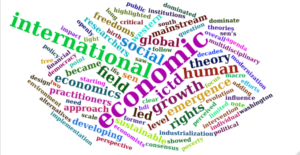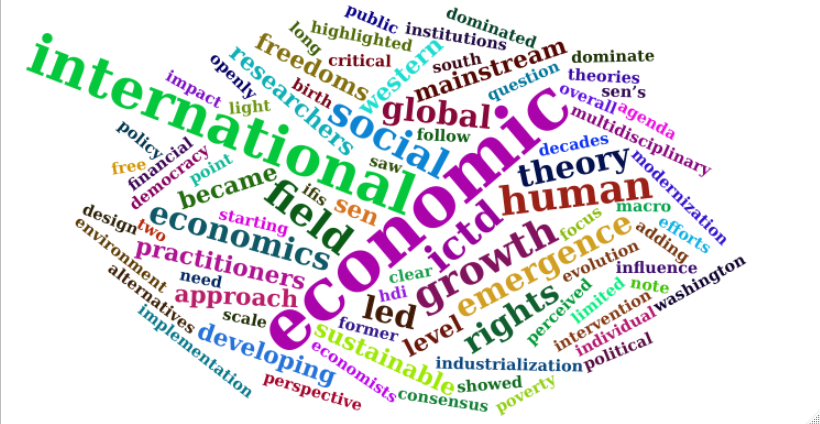ICT for Development (ICTD) has been around for over three decades. A multidisciplinary field involving researchers and practitioners from many different areas and backgrounds, ICTD has one clear objective: to deploy new ICTs in society to foster development.  The first and most obvious question is how this can happen. The answer is not trivial. Nevertheless, my focus on this post is instead on the development side of the equation. How exactly is development defined and perceived by ICTD? One thing is clear. There is no agreement on the actual definition of the concept. Revisiting the evolution of international development thus might be a useful starting point to address the question.
The first and most obvious question is how this can happen. The answer is not trivial. Nevertheless, my focus on this post is instead on the development side of the equation. How exactly is development defined and perceived by ICTD? One thing is clear. There is no agreement on the actual definition of the concept. Revisiting the evolution of international development thus might be a useful starting point to address the question.
Just like ICTD, the international development field is also multi-disciplinary. A few decades older than the former, it first saw the light of day in the 1950s. Its origins can be traced back to the emergence of Modernization Theory that, while not monolithic, espoused that countries in the Global South should follow the same developmental path as more advanced Western nations. However, modernization was not limited to economists. Other well-reputed social science researchers and practitioners were part and parcel of its evolution. Social and cultural issues, for example, were also seen as critical as economics, if not more.
At the macro level, the theory envisioned industrialization as the first step and one that will eventually lead to democracy, the spread of Western values and overall human well-being. Development was perceived as a uniform, linear, and progressive process comprising sequential steps that countries need to follow. Given the macro focus on industrialization, economic development and economic growth became top priorities and core targets of any development-related intervention. Democracy could wait a few years if need be.
As highlighted by some authors, international development has been, from its inception, a geopolitical mine. Three distinct elements led to its birth. First, the then-new Cold War between two superpowers competing for influence on a global scale. Second, the formal end of colonialism and the emergence of a new set of independent countries in the late 1950s provided additional fodder to such competition while adding more complexity to the field. And third, the emergence of a new intelligentsia in former colonies, led by Latin America, openly challenged development theories crafted in the North while putting on the table the idiosyncrasies of countries on the periphery of capitalism. The success of the Cuban Revolution showed alternative ways of achieving autonomous development, at least on paper. In this light, the role of International Financial Institutions (IFIs) and multilateral and bilateral development agencies became critical from Western countries’ vantage point.
Additional international development alternatives emerged in the early 1970s. One highlighted the negative impact of rapid economic development on the environment, openly calling for limiting relentless growth to preserve nature. A long decade later, these efforts materialized in the concept of Sustainable Development that merged economic growth, social inclusion and the environment. That led to the first-ever sustainable development global meeting, the UN Earth Summit in Rio de Janeiro in 1992. UN member states endorsed the implementation of Agenda 21.
Challenges to economic growth as the prime mover for development also came from within mainstream economics. Sen’s 1980s critique of mainstream Welfare Economics theory led to the Capabilities Approach (CA). This perspective added individual rights and freedoms into an otherwise purely economic equation. Sen identified five “instrumental freedoms” associated with economic facilities, social opportunities, political rights, social protection and trust. All these freedoms, Sen argued, were closely interrelated and backed by capable national institutions that secured sustainability in the medium and long term. As a result, CA was subsumed under the banner of Human Development at the policy level, which became the primary driver for the UN Development Human Development Index (HDI) in 1990 and the Human Development Report’s annual publishing. The HDI, however, does not capture all of Sen’s instrumental freedoms. Note also that Sen moved the bar from the macro-level to the micro or individual level, which was a perfect match for the human rights agenda, limited to civil and political rights, that dominated the arena.
Almost in parallel fashion, the leading IFIs embraced the Washington Consensus (WC) approach that initially stipulated 10 policy principles developing countries should adopt to conditionally secure much-needed external financing. While not a comprehensive development theory, the Washington Consensus disregarded most other development alternatives. It also directly targeted and dominated public policymaking in the Global South. Moreover, the approach had the imprint of neoliberalism with the expected emphasis on privatization, free markets, free trade, and minimal state intervention.
The 1997 Asian Financial Crisis showed this perspective’s severe limitations, and calls for a complete overhaul promptly popped up. The World Bank added anti-corruption efforts and the promotion of good governance to its poverty mandate, thus adding an institutional design dimension to its work while switching from development per se to poverty reduction as the ultimate outcome. The new millennium saw the post-Washington Consensus’s birth (PWC), a softer and more elaborate version of the original that preserved its neoliberal personality.
While the above constitute some of the most well-known approaches to development economics, many others have been developed outside the mainstream and the Anglo-dominated academic research (see Reinert et al. cited below for details).
We can now draw two overall conclusions. First, international development has been driven by economic development and economic growth, especially when designing and implementing public policies in developing countries. While the emergence of Sustainable Development has introduced more nuances to the issue, economists still tend to dominate the field and influence how countries move ahead on the development scale -if there is really one out there. Second, while there are indeed many theories and concepts on international development, not all of them have been created equal. In fact, a few of them dominate the field and have had the most (and sometimes devastating) impact on developing countries.
ICTD researchers and practitioners should take note of this, mainly if their target is to influence ICT policymaking in the Global South.
Cheers, Raúl
Selected References
5575045
{5575045:YNJBGEJ7},{5575045:4H4RS8CX},{5575045:NLDFEHYB},{5575045:TIRLNP99},{5575045:HSMF28BG},{5575045:AK35MYGV},{5575045:S65S8K5C},{5575045:533JZKK9},{5575045:NVY4658Q},{5575045:CUK235EY},{5575045:MZDSTV47},{5575045:PE4ESIC2},{5575045:VZPC6F8R},{5575045:HIKR5ZLL},{5575045:LE2ZLQ24},{5575045:RUISZUHN},{5575045:6WXMCJP7},{5575045:LB8XAHIQ},{5575045:J3FWQM97},{5575045:EMTFPQYN}
1
apa
50
creator
asc
10836
https://blog.raulza.me/wp-content/plugins/zotpress/
%7B%22status%22%3A%22success%22%2C%22updateneeded%22%3Afalse%2C%22instance%22%3Afalse%2C%22meta%22%3A%7B%22request_last%22%3A0%2C%22request_next%22%3A0%2C%22used_cache%22%3Atrue%7D%2C%22data%22%3A%5B%7B%22key%22%3A%22LB8XAHIQ%22%2C%22library%22%3A%7B%22id%22%3A5575045%7D%2C%22meta%22%3A%7B%22creatorSummary%22%3A%22Amin%22%2C%22parsedDate%22%3A%221976%22%2C%22numChildren%22%3A0%7D%2C%22bib%22%3A%22%26lt%3Bdiv%20class%3D%26quot%3Bcsl-bib-body%26quot%3B%20style%3D%26quot%3Bline-height%3A%202%3B%20padding-left%3A%201em%3B%20text-indent%3A-1em%3B%26quot%3B%26gt%3B%5Cn%20%20%26lt%3Bdiv%20class%3D%26quot%3Bcsl-entry%26quot%3B%26gt%3BAmin%2C%20S.%20%281976%29.%20%26lt%3Bi%26gt%3BUnequal%20development%3A%20an%20essay%20on%20the%20social%20formations%20of%20peripheral%20capitalism%26lt%3B%5C%2Fi%26gt%3B.%20Monthly%20Review%20Press.%26lt%3B%5C%2Fdiv%26gt%3B%5Cn%26lt%3B%5C%2Fdiv%26gt%3B%22%2C%22data%22%3A%7B%22itemType%22%3A%22book%22%2C%22title%22%3A%22Unequal%20development%3A%20an%20essay%20on%20the%20social%20formations%20of%20peripheral%20capitalism%22%2C%22creators%22%3A%5B%7B%22creatorType%22%3A%22author%22%2C%22firstName%22%3A%22Samir%22%2C%22lastName%22%3A%22Amin%22%7D%5D%2C%22abstractNote%22%3A%22%22%2C%22date%22%3A%221976%22%2C%22language%22%3A%22English%22%2C%22ISBN%22%3A%22978-0-85345-433-5%22%2C%22url%22%3A%22%22%2C%22collections%22%3A%5B%22UCXNBSZI%22%5D%2C%22dateModified%22%3A%222020-12-25T13%3A56%3A06Z%22%7D%7D%2C%7B%22key%22%3A%22YNJBGEJ7%22%2C%22library%22%3A%7B%22id%22%3A5575045%7D%2C%22meta%22%3A%7B%22creatorSummary%22%3A%22Escobar%22%2C%22parsedDate%22%3A%222012%22%2C%22numChildren%22%3A0%7D%2C%22bib%22%3A%22%26lt%3Bdiv%20class%3D%26quot%3Bcsl-bib-body%26quot%3B%20style%3D%26quot%3Bline-height%3A%202%3B%20padding-left%3A%201em%3B%20text-indent%3A-1em%3B%26quot%3B%26gt%3B%5Cn%20%20%26lt%3Bdiv%20class%3D%26quot%3Bcsl-entry%26quot%3B%26gt%3BEscobar%2C%20A.%20%282012%29.%20%26lt%3Bi%26gt%3BEncountering%20development%3A%20the%20making%20and%20unmaking%20of%20the%20third%20world%26lt%3B%5C%2Fi%26gt%3B.%20Princeton%20University%20Press.%26lt%3B%5C%2Fdiv%26gt%3B%5Cn%26lt%3B%5C%2Fdiv%26gt%3B%22%2C%22data%22%3A%7B%22itemType%22%3A%22book%22%2C%22title%22%3A%22Encountering%20development%3A%20the%20making%20and%20unmaking%20of%20the%20third%20world%22%2C%22creators%22%3A%5B%7B%22creatorType%22%3A%22author%22%2C%22firstName%22%3A%22Arturo%22%2C%22lastName%22%3A%22Escobar%22%7D%5D%2C%22abstractNote%22%3A%22%22%2C%22date%22%3A%222012%20%281995%29%22%2C%22language%22%3A%22%22%2C%22ISBN%22%3A%22978-0-691-15045-1%22%2C%22url%22%3A%22%22%2C%22collections%22%3A%5B%22Q5K6B4UD%22%5D%2C%22dateModified%22%3A%222020-08-23T11%3A33%3A10Z%22%7D%7D%2C%7B%22key%22%3A%226WXMCJP7%22%2C%22library%22%3A%7B%22id%22%3A5575045%7D%2C%22meta%22%3A%7B%22creatorSummary%22%3A%22Evans%22%2C%22parsedDate%22%3A%221995%22%2C%22numChildren%22%3A0%7D%2C%22bib%22%3A%22%26lt%3Bdiv%20class%3D%26quot%3Bcsl-bib-body%26quot%3B%20style%3D%26quot%3Bline-height%3A%202%3B%20padding-left%3A%201em%3B%20text-indent%3A-1em%3B%26quot%3B%26gt%3B%5Cn%20%20%26lt%3Bdiv%20class%3D%26quot%3Bcsl-entry%26quot%3B%26gt%3BEvans%2C%20P.%20B.%20%281995%29.%20%26lt%3Bi%26gt%3BEmbedded%20autonomy%3A%20states%20and%20industrial%20transformation%26lt%3B%5C%2Fi%26gt%3B.%20Princeton%20University%20Press.%26lt%3B%5C%2Fdiv%26gt%3B%5Cn%26lt%3B%5C%2Fdiv%26gt%3B%22%2C%22data%22%3A%7B%22itemType%22%3A%22book%22%2C%22title%22%3A%22Embedded%20autonomy%3A%20states%20and%20industrial%20transformation%22%2C%22creators%22%3A%5B%7B%22creatorType%22%3A%22author%22%2C%22firstName%22%3A%22Peter%20B.%22%2C%22lastName%22%3A%22Evans%22%7D%5D%2C%22abstractNote%22%3A%22%22%2C%22date%22%3A%221995%22%2C%22language%22%3A%22%22%2C%22ISBN%22%3A%22978-0-691-03737-0%20978-0-691-03736-3%22%2C%22url%22%3A%22%22%2C%22collections%22%3A%5B%22Q5K6B4UD%22%5D%2C%22dateModified%22%3A%222020-08-14T21%3A16%3A34Z%22%7D%7D%2C%7B%22key%22%3A%22CUK235EY%22%2C%22library%22%3A%7B%22id%22%3A5575045%7D%2C%22meta%22%3A%7B%22creatorSummary%22%3A%22Fukuda-Parr%22%2C%22parsedDate%22%3A%222003-01-01%22%2C%22numChildren%22%3A1%7D%2C%22bib%22%3A%22%26lt%3Bdiv%20class%3D%26quot%3Bcsl-bib-body%26quot%3B%20style%3D%26quot%3Bline-height%3A%202%3B%20padding-left%3A%201em%3B%20text-indent%3A-1em%3B%26quot%3B%26gt%3B%5Cn%20%20%26lt%3Bdiv%20class%3D%26quot%3Bcsl-entry%26quot%3B%26gt%3BFukuda-Parr%2C%20S.%20%282003%29.%20The%20Human%20Development%20Paradigm%3A%20Operationalizing%20Sen%26%23×2019%3Bs%20Ideas%20on%20Capabilities.%20%26lt%3Bi%26gt%3BFeminist%20Economics%26lt%3B%5C%2Fi%26gt%3B%2C%20%26lt%3Bi%26gt%3B9%26lt%3B%5C%2Fi%26gt%3B%282%26%23×2013%3B3%29%2C%20301%26%23×2013%3B317.%20%26lt%3Ba%20class%3D%26%23039%3Bzp-ItemURL%26%23039%3B%20href%3D%26%23039%3Bhttps%3A%5C%2F%5C%2Fdoi.org%5C%2F10.1080%5C%2F1354570022000077980%26%23039%3B%26gt%3Bhttps%3A%5C%2F%5C%2Fdoi.org%5C%2F10.1080%5C%2F1354570022000077980%26lt%3B%5C%2Fa%26gt%3B%26lt%3B%5C%2Fdiv%26gt%3B%5Cn%26lt%3B%5C%2Fdiv%26gt%3B%22%2C%22data%22%3A%7B%22itemType%22%3A%22journalArticle%22%2C%22title%22%3A%22The%20Human%20Development%20Paradigm%3A%20Operationalizing%20Sen%27s%20Ideas%20on%20Capabilities%22%2C%22creators%22%3A%5B%7B%22creatorType%22%3A%22author%22%2C%22firstName%22%3A%22Sakiko%22%2C%22lastName%22%3A%22Fukuda-Parr%22%7D%5D%2C%22abstractNote%22%3A%22Amartya%20Sen%26%23039%3Bs%20ideas%20constitute%20the%20core%20principles%20of%20a%20development%20approach%20that%20has%20evolved%20in%20the%20Human%20Development%20Reports.%20This%20approach%20is%20a%20%26quot%3Bparadigm%26quot%3B%20based%20on%20the%20concept%20of%20well-being%20that%20can%20help%20define%20public%20policy%2C%20but%20does%20not%20embody%20a%20set%20of%20prescriptions.%20The%20current%20movement%20from%20an%20age%20of%20development%20planning%20to%20an%20age%20of%20globalization%20has%20meant%20an%20increasing%20attention%20to%20agency%20aspects%20of%20development.%20While%20earlier%20Human%20Development%20Reports%20emphasized%20measures%20such%20as%20the%20provision%20of%20public%20services%2C%20recent%20ones%20have%20focused%20more%20on%20people%26%23039%3Bs%20political%20empowerment.%20This%20paper%20reflects%20on%20Sen%26%23039%3Bs%20work%20in%20light%20of%20this%20shift%20in%20emphasis.%20Gender%20analysis%20has%20been%20central%20to%20the%20development%20of%20the%20new%20agency-driven%20paradigm%2C%20and%20gender%20equity%20is%20a%20core%20concern.%20A%20gender%20perspective%20has%20also%20helped%20highlight%20important%20aspects%20of%20this%20paradigm%2C%20such%20as%20the%20role%20of%20collective%20agency%20in%20promoting%20development.%22%2C%22date%22%3A%22January%201%2C%202003%22%2C%22language%22%3A%22%22%2C%22DOI%22%3A%2210.1080%5C%2F1354570022000077980%22%2C%22ISSN%22%3A%221354-5701%22%2C%22url%22%3A%22https%3A%5C%2F%5C%2Fdoi.org%5C%2F10.1080%5C%2F1354570022000077980%22%2C%22collections%22%3A%5B%22Q5K6B4UD%22%5D%2C%22dateModified%22%3A%222020-08-16T18%3A18%3A18Z%22%7D%7D%2C%7B%22key%22%3A%22PE4ESIC2%22%2C%22library%22%3A%7B%22id%22%3A5575045%7D%2C%22meta%22%3A%7B%22creatorSummary%22%3A%22Gore%22%2C%22parsedDate%22%3A%222000-05-01%22%2C%22numChildren%22%3A1%7D%2C%22bib%22%3A%22%26lt%3Bdiv%20class%3D%26quot%3Bcsl-bib-body%26quot%3B%20style%3D%26quot%3Bline-height%3A%202%3B%20padding-left%3A%201em%3B%20text-indent%3A-1em%3B%26quot%3B%26gt%3B%5Cn%20%20%26lt%3Bdiv%20class%3D%26quot%3Bcsl-entry%26quot%3B%26gt%3BGore%2C%20C.%20%282000%29.%20The%20Rise%20and%20Fall%20of%20the%20Washington%20Consensus%20as%20a%20Paradigm%20for%20Developing%20Countries.%20%26lt%3Bi%26gt%3BWorld%20Development%26lt%3B%5C%2Fi%26gt%3B%2C%20%26lt%3Bi%26gt%3B28%26lt%3B%5C%2Fi%26gt%3B%285%29%2C%20789%26%23×2013%3B804.%20%26lt%3Ba%20class%3D%26%23039%3Bzp-DOIURL%26%23039%3B%20href%3D%26%23039%3Bhttps%3A%5C%2F%5C%2Fdoi.org%5C%2F10%5C%2Ffszmpt%26%23039%3B%26gt%3Bhttps%3A%5C%2F%5C%2Fdoi.org%5C%2F10%5C%2Ffszmpt%26lt%3B%5C%2Fa%26gt%3B%26lt%3B%5C%2Fdiv%26gt%3B%5Cn%26lt%3B%5C%2Fdiv%26gt%3B%22%2C%22data%22%3A%7B%22itemType%22%3A%22journalArticle%22%2C%22title%22%3A%22The%20Rise%20and%20Fall%20of%20the%20Washington%20Consensus%20as%20a%20Paradigm%20for%20Developing%20Countries%22%2C%22creators%22%3A%5B%7B%22creatorType%22%3A%22author%22%2C%22firstName%22%3A%22Charles%22%2C%22lastName%22%3A%22Gore%22%7D%5D%2C%22abstractNote%22%3A%22The%20introduction%20of%20the%20Washington%20Consensus%20involved%20not%20simply%20a%20swing%20from%20state-led%20to%20market-oriented%20policies%2C%20but%20also%20a%20shift%20in%20the%20ways%20in%20which%20development%20problems%20were%20framed%20and%20in%20the%20types%20of%20explanation%20through%20which%20policies%20were%20justified.%20Key%20changes%20were%20the%20partial%20globalization%20of%20development%20policy%20analysis%2C%20and%20a%20shift%20from%20historicism%20to%20ahistorical%20performance%20assessment.%20The%20main%20challenge%20to%20this%20approach%20is%20a%20latent%20Southern%20Consensus%2C%20which%20is%20apparent%20in%20the%20convergence%20between%20East%20Asian%20developmentalism%20and%20Latin%20American%20neostructuralism.%20The%20demise%20of%20the%20Washington%20Consensus%20is%20inevitable%20because%20its%20methodology%20and%20ideology%20are%20in%20contradiction.%22%2C%22date%22%3A%22May%201%2C%202000%22%2C%22language%22%3A%22en%22%2C%22DOI%22%3A%2210%5C%2Ffszmpt%22%2C%22ISSN%22%3A%220305-750X%22%2C%22url%22%3A%22http%3A%5C%2F%5C%2Fwww.sciencedirect.com%5C%2Fscience%5C%2Farticle%5C%2Fpii%5C%2FS0305750X99001606%22%2C%22collections%22%3A%5B%22Q5K6B4UD%22%5D%2C%22dateModified%22%3A%222020-08-16T20%3A01%3A40Z%22%7D%7D%2C%7B%22key%22%3A%22LE2ZLQ24%22%2C%22library%22%3A%7B%22id%22%3A5575045%7D%2C%22meta%22%3A%7B%22creatorSummary%22%3A%22G%5Cu00fcven%22%2C%22parsedDate%22%3A%222018-05-04%22%2C%22numChildren%22%3A1%7D%2C%22bib%22%3A%22%26lt%3Bdiv%20class%3D%26quot%3Bcsl-bib-body%26quot%3B%20style%3D%26quot%3Bline-height%3A%202%3B%20padding-left%3A%201em%3B%20text-indent%3A-1em%3B%26quot%3B%26gt%3B%5Cn%20%20%26lt%3Bdiv%20class%3D%26quot%3Bcsl-entry%26quot%3B%26gt%3BG%26%23xFC%3Bven%2C%20A.%20B.%20%282018%29.%20Whither%20the%20post-Washington%20Consensus%3F%20International%20financial%20institutions%20and%20development%20policy%20before%20and%20after%20the%20crisis.%20%26lt%3Bi%26gt%3BReview%20of%20International%20Political%20Economy%26lt%3B%5C%2Fi%26gt%3B%2C%20%26lt%3Bi%26gt%3B25%26lt%3B%5C%2Fi%26gt%3B%283%29%2C%20392%26%23×2013%3B417.%20%26lt%3Ba%20class%3D%26%23039%3Bzp-DOIURL%26%23039%3B%20href%3D%26%23039%3Bhttps%3A%5C%2F%5C%2Fdoi.org%5C%2F10%5C%2Fgg79c9%26%23039%3B%26gt%3Bhttps%3A%5C%2F%5C%2Fdoi.org%5C%2F10%5C%2Fgg79c9%26lt%3B%5C%2Fa%26gt%3B%26lt%3B%5C%2Fdiv%26gt%3B%5Cn%26lt%3B%5C%2Fdiv%26gt%3B%22%2C%22data%22%3A%7B%22itemType%22%3A%22journalArticle%22%2C%22title%22%3A%22Whither%20the%20post-Washington%20Consensus%3F%20International%20financial%20institutions%20and%20development%20policy%20before%20and%20after%20the%20crisis%22%2C%22creators%22%3A%5B%7B%22creatorType%22%3A%22author%22%2C%22firstName%22%3A%22Ali%20Burak%22%2C%22lastName%22%3A%22G%5Cu00fcven%22%7D%5D%2C%22abstractNote%22%3A%22This%20article%20explores%20the%20direction%2C%20drivers%20and%20implications%20of%20change%20in%20the%20International%20Monetary%20Fund%20%28IMF%29%20and%20the%20World%20Bank%5Cu2019s%20policy%20vision%20for%20developing%20countries%20before%20and%20after%20the%20global%20economic%20crisis.%20By%20examining%20the%20evolution%20of%20the%20Fund%5Cu2019s%20structural%20conditionalities%20and%20the%20thematic%20distribution%20of%20Bank%20commitments%2C%20it%20provides%20evidence%20for%20a%20significant%20change%20on%20the%20ground%3A%20a%20partial%20retreat%20from%20the%20post-Washington%20Consensus%20%28PWC%29%20agenda%2C%20which%20marked%20a%20turn-of-the-century%20upgrade%20of%20orthodox%20neoliberalism.%20Conceptualising%20the%20PWC%20as%20a%20paradigm%20expansion%20that%20followed%20severe%20policy%20failures%2C%20the%20analysis%20finds%20that%20although%20narrow%20institutional%20reforms%20towards%20upgrading%20fiscal%20and%20financial%20regimes%20remain%20popular%2C%20there%20is%20now%20less%20emphasis%20on%20good%20governance%20and%20broad%20institutions%3B%20meanwhile%20in%20social%20policy%20the%20twins%20increasingly%20diverge.%20It%20is%20argued%20that%20this%20selective%20disengagement%20is%20driven%20by%20extant%20operational%20imperatives%20and%20constraints%2C%20which%20are%20further%20intensified%20by%20changes%20in%20lending%20framework%20and%20ongoing%20transformations%20in%20development%20finance.%20Rather%20than%20constitute%20a%20paradigm%20shift%2C%20the%20partial%20decline%20of%20the%20PWC%20reflects%20an%20adjustment%20in%20policy%20practice%20towards%20increased%20flexibility%20and%20discretion%20in%20a%20progressively%20challenging%20environment.%20These%20findings%20have%20implications%20for%20the%20study%20of%20the%20twins.%20They%20also%20highlight%20the%20evolving%20parameters%20of%20North%5Cu2013South%20development%20cooperation.%22%2C%22date%22%3A%22May%204%2C%202018%22%2C%22language%22%3A%22%22%2C%22DOI%22%3A%2210%5C%2Fgg79c9%22%2C%22ISSN%22%3A%220969-2290%22%2C%22url%22%3A%22https%3A%5C%2F%5C%2Fdoi.org%5C%2F10.1080%5C%2F09692290.2018.1459781%22%2C%22collections%22%3A%5B%22Q5K6B4UD%22%5D%2C%22dateModified%22%3A%222020-08-17T11%3A00%3A47Z%22%7D%7D%2C%7B%22key%22%3A%22EMTFPQYN%22%2C%22library%22%3A%7B%22id%22%3A5575045%7D%2C%22meta%22%3A%7B%22creatorSummary%22%3A%22Hirschman%22%2C%22parsedDate%22%3A%221971%22%2C%22numChildren%22%3A0%7D%2C%22bib%22%3A%22%26lt%3Bdiv%20class%3D%26quot%3Bcsl-bib-body%26quot%3B%20style%3D%26quot%3Bline-height%3A%202%3B%20padding-left%3A%201em%3B%20text-indent%3A-1em%3B%26quot%3B%26gt%3B%5Cn%20%20%26lt%3Bdiv%20class%3D%26quot%3Bcsl-entry%26quot%3B%26gt%3BHirschman%2C%20A.%20O.%20%281971%29.%20%26lt%3Bi%26gt%3BA%20bias%20for%20hope%3A%20essays%20on%20development%20and%20Latin%20America%26lt%3B%5C%2Fi%26gt%3B.%20Yale%20University%20Press.%26lt%3B%5C%2Fdiv%26gt%3B%5Cn%26lt%3B%5C%2Fdiv%26gt%3B%22%2C%22data%22%3A%7B%22itemType%22%3A%22book%22%2C%22title%22%3A%22A%20bias%20for%20hope%3A%20essays%20on%20development%20and%20Latin%20America%22%2C%22creators%22%3A%5B%7B%22creatorType%22%3A%22author%22%2C%22firstName%22%3A%22Albert%20O.%22%2C%22lastName%22%3A%22Hirschman%22%7D%5D%2C%22abstractNote%22%3A%22%22%2C%22date%22%3A%221971%22%2C%22language%22%3A%22%22%2C%22ISBN%22%3A%22978-0-300-01456-3%20978-0-300-01490-7%22%2C%22url%22%3A%22%22%2C%22collections%22%3A%5B%22UCXNBSZI%22%5D%2C%22dateModified%22%3A%222020-12-25T14%3A06%3A36Z%22%7D%7D%2C%7B%22key%22%3A%224H4RS8CX%22%2C%22library%22%3A%7B%22id%22%3A5575045%7D%2C%22meta%22%3A%7B%22creatorSummary%22%3A%22Meadows%20and%20Club%20of%20Rome%22%2C%22parsedDate%22%3A%221972%22%2C%22numChildren%22%3A0%7D%2C%22bib%22%3A%22%26lt%3Bdiv%20class%3D%26quot%3Bcsl-bib-body%26quot%3B%20style%3D%26quot%3Bline-height%3A%202%3B%20padding-left%3A%201em%3B%20text-indent%3A-1em%3B%26quot%3B%26gt%3B%5Cn%20%20%26lt%3Bdiv%20class%3D%26quot%3Bcsl-entry%26quot%3B%26gt%3BMeadows%2C%20D.%20H.%2C%20%26amp%3B%20Club%20of%20Rome%20%28Eds.%29.%20%281972%29.%20%26lt%3Bi%26gt%3BThe%20Limits%20to%20growth%3A%20a%20report%20for%20the%20Club%20of%20Rome%26%23×2019%3Bs%20project%20on%20the%20predicament%20of%20mankind%26lt%3B%5C%2Fi%26gt%3B.%20Universe%20Books.%26lt%3B%5C%2Fdiv%26gt%3B%5Cn%26lt%3B%5C%2Fdiv%26gt%3B%22%2C%22data%22%3A%7B%22itemType%22%3A%22book%22%2C%22title%22%3A%22The%20Limits%20to%20growth%3A%20a%20report%20for%20the%20Club%20of%20Rome%27s%20project%20on%20the%20predicament%20of%20mankind%22%2C%22creators%22%3A%5B%7B%22creatorType%22%3A%22editor%22%2C%22firstName%22%3A%22Donella%20H.%22%2C%22lastName%22%3A%22Meadows%22%7D%2C%7B%22creatorType%22%3A%22editor%22%2C%22firstName%22%3A%22%22%2C%22lastName%22%3A%22Club%20of%20Rome%22%7D%5D%2C%22abstractNote%22%3A%22%22%2C%22date%22%3A%221972%22%2C%22language%22%3A%22%22%2C%22ISBN%22%3A%22978-0-87663-165-2%22%2C%22url%22%3A%22%22%2C%22collections%22%3A%5B%22UCXNBSZI%22%5D%2C%22dateModified%22%3A%222019-03-26T20%3A35%3A32Z%22%7D%7D%2C%7B%22key%22%3A%22NLDFEHYB%22%2C%22library%22%3A%7B%22id%22%3A5575045%7D%2C%22meta%22%3A%7B%22creatorSummary%22%3A%22Power%22%2C%22parsedDate%22%3A%222018%22%2C%22numChildren%22%3A0%7D%2C%22bib%22%3A%22%26lt%3Bdiv%20class%3D%26quot%3Bcsl-bib-body%26quot%3B%20style%3D%26quot%3Bline-height%3A%202%3B%20padding-left%3A%201em%3B%20text-indent%3A-1em%3B%26quot%3B%26gt%3B%5Cn%20%20%26lt%3Bdiv%20class%3D%26quot%3Bcsl-entry%26quot%3B%26gt%3BPower%2C%20M.%20%282018%29.%20Modernization%20Theories%20of%20Development.%20In%20%26lt%3Bi%26gt%3BThe%20International%20Encyclopedia%20of%20Anthropology%26lt%3B%5C%2Fi%26gt%3B%20%28pp.%201%26%23×2013%3B8%29.%20Wiley.%20%26lt%3Ba%20class%3D%26%23039%3Bzp-ItemURL%26%23039%3B%20href%3D%26%23039%3Bhttp%3A%5C%2F%5C%2Fonlinelibrary.wiley.com%5C%2Fdoi%5C%2Fabs%5C%2F10.1002%5C%2F9781118924396.wbiea1888%26%23039%3B%26gt%3Bhttp%3A%5C%2F%5C%2Fonlinelibrary.wiley.com%5C%2Fdoi%5C%2Fabs%5C%2F10.1002%5C%2F9781118924396.wbiea1888%26lt%3B%5C%2Fa%26gt%3B%26lt%3B%5C%2Fdiv%26gt%3B%5Cn%26lt%3B%5C%2Fdiv%26gt%3B%22%2C%22data%22%3A%7B%22itemType%22%3A%22bookSection%22%2C%22title%22%3A%22Modernization%20Theories%20of%20Development%22%2C%22creators%22%3A%5B%7B%22creatorType%22%3A%22author%22%2C%22firstName%22%3A%22Marcus%22%2C%22lastName%22%3A%22Power%22%7D%5D%2C%22abstractNote%22%3A%22Modernization%20approaches%20have%20been%20one%20of%20the%20most%20influential%20theoretical%20perspectives%20on%20development%20since%20their%20emergence%20in%20the%201950s.%20Primarily%20attention%20has%20been%20focused%20on%20the%20ways%20in%20which%20past%20and%20present%20premodern%20societies%20become%20modern%20%28i.e.%2C%20westernized%29%20through%20processes%20of%20economic%20growth%20and%20social%2C%20cultural%2C%20and%20political%20change.%20Although%20there%20is%20no%20single%20theory%20of%20modernization%20%28but%2C%20rather%2C%20an%20assortment%20of%20related%20theories%20and%20perspectives%29%2C%20collectively%20this%20body%20of%20work%20refers%20to%20a%20description%20and%20explanation%20of%20the%20processes%20of%20transformation%20from%20traditional%20or%20underdeveloped%20societies%20to%20modern%20societies%20and%20envisages%20a%20process%20of%20change%20toward%20those%20types%20of%20social%2C%20economic%2C%20and%20political%20systems%20that%20have%20developed%20in%20Western%20Europe%20and%20North%20America.%22%2C%22bookTitle%22%3A%22The%20International%20Encyclopedia%20of%20Anthropology%22%2C%22date%22%3A%222018%22%2C%22language%22%3A%22en%22%2C%22ISBN%22%3A%22978-1-118-92439-6%22%2C%22url%22%3A%22http%3A%5C%2F%5C%2Fonlinelibrary.wiley.com%5C%2Fdoi%5C%2Fabs%5C%2F10.1002%5C%2F9781118924396.wbiea1888%22%2C%22collections%22%3A%5B%22Q5K6B4UD%22%5D%2C%22dateModified%22%3A%222020-12-24T22%3A11%3A05Z%22%7D%7D%2C%7B%22key%22%3A%22TIRLNP99%22%2C%22library%22%3A%7B%22id%22%3A5575045%7D%2C%22meta%22%3A%7B%22creatorSummary%22%3A%22Quijano%22%2C%22parsedDate%22%3A%222016-06-29%22%2C%22numChildren%22%3A1%7D%2C%22bib%22%3A%22%26lt%3Bdiv%20class%3D%26quot%3Bcsl-bib-body%26quot%3B%20style%3D%26quot%3Bline-height%3A%202%3B%20padding-left%3A%201em%3B%20text-indent%3A-1em%3B%26quot%3B%26gt%3B%5Cn%20%20%26lt%3Bdiv%20class%3D%26quot%3Bcsl-entry%26quot%3B%26gt%3BQuijano%2C%20A.%20%282016%29.%20Coloniality%20of%20Power%20and%20Eurocentrism%20in%20Latin%20America%3A%20%26lt%3Bi%26gt%3BInternational%20Sociology%26lt%3B%5C%2Fi%26gt%3B.%20%26lt%3Ba%20class%3D%26%23039%3Bzp-DOIURL%26%23039%3B%20href%3D%26%23039%3Bhttps%3A%5C%2F%5C%2Fdoi.org%5C%2F10%5C%2Fffx3tf%26%23039%3B%26gt%3Bhttps%3A%5C%2F%5C%2Fdoi.org%5C%2F10%5C%2Fffx3tf%26lt%3B%5C%2Fa%26gt%3B%26lt%3B%5C%2Fdiv%26gt%3B%5Cn%26lt%3B%5C%2Fdiv%26gt%3B%22%2C%22data%22%3A%7B%22itemType%22%3A%22journalArticle%22%2C%22title%22%3A%22Coloniality%20of%20Power%20and%20Eurocentrism%20in%20Latin%20America%3A%22%2C%22creators%22%3A%5B%7B%22creatorType%22%3A%22author%22%2C%22firstName%22%3A%22An%5Cu00edbal%22%2C%22lastName%22%3A%22Quijano%22%7D%5D%2C%22abstractNote%22%3A%22The%20globalization%20of%20the%20world%20is%2C%20in%20the%20first%20place%2C%20the%20culmination%20of%20a%20process%20that%20began%20with%20the%20constitution%20of%20America%20and%20world%20capitalism%20as%20a%20Euro-c…%22%2C%22date%22%3A%22June%2029%2C%202016%22%2C%22language%22%3A%22en%22%2C%22DOI%22%3A%2210%5C%2Fffx3tf%22%2C%22ISSN%22%3A%22%22%2C%22url%22%3A%22http%3A%5C%2F%5C%2Fjournals.sagepub.com%5C%2Fdoi%5C%2F10.1177%5C%2F0268580900015002005%22%2C%22collections%22%3A%5B%22Q5K6B4UD%22%5D%2C%22dateModified%22%3A%222020-10-07T21%3A08%3A54Z%22%7D%7D%2C%7B%22key%22%3A%22RUISZUHN%22%2C%22library%22%3A%7B%22id%22%3A5575045%7D%2C%22meta%22%3A%7B%22creatorSummary%22%3A%22Reinert%20et%20al.%22%2C%22parsedDate%22%3A%222016%22%2C%22numChildren%22%3A1%7D%2C%22bib%22%3A%22%26lt%3Bdiv%20class%3D%26quot%3Bcsl-bib-body%26quot%3B%20style%3D%26quot%3Bline-height%3A%202%3B%20padding-left%3A%201em%3B%20text-indent%3A-1em%3B%26quot%3B%26gt%3B%5Cn%20%20%26lt%3Bdiv%20class%3D%26quot%3Bcsl-entry%26quot%3B%26gt%3BReinert%2C%20E.%20S.%2C%20Ghosh%2C%20J.%2C%20%26amp%3B%20Kattel%2C%20R.%20%28Eds.%29.%20%282016%29.%20%26lt%3Bi%26gt%3BHandbook%20of%20alternative%20theories%20of%20economic%20development%26lt%3B%5C%2Fi%26gt%3B.%20Edward%20Elgar%20Publishing.%26lt%3B%5C%2Fdiv%26gt%3B%5Cn%26lt%3B%5C%2Fdiv%26gt%3B%22%2C%22data%22%3A%7B%22itemType%22%3A%22book%22%2C%22title%22%3A%22Handbook%20of%20alternative%20theories%20of%20economic%20development%22%2C%22creators%22%3A%5B%7B%22creatorType%22%3A%22editor%22%2C%22firstName%22%3A%22Erik%20S.%22%2C%22lastName%22%3A%22Reinert%22%7D%2C%7B%22creatorType%22%3A%22editor%22%2C%22firstName%22%3A%22Jayati%22%2C%22lastName%22%3A%22Ghosh%22%7D%2C%7B%22creatorType%22%3A%22editor%22%2C%22firstName%22%3A%22Rainer%22%2C%22lastName%22%3A%22Kattel%22%7D%5D%2C%22abstractNote%22%3A%22%22%2C%22date%22%3A%222016%22%2C%22language%22%3A%22eng%22%2C%22ISBN%22%3A%22978-1-78254-468-5%20978-1-78254-466-1%20978-1-78254-467-8%22%2C%22url%22%3A%22%22%2C%22collections%22%3A%5B%22UCXNBSZI%22%5D%2C%22dateModified%22%3A%222020-12-25T13%3A45%3A52Z%22%7D%7D%2C%7B%22key%22%3A%22HSMF28BG%22%2C%22library%22%3A%7B%22id%22%3A5575045%7D%2C%22meta%22%3A%7B%22creatorSummary%22%3A%22Rostow%22%2C%22parsedDate%22%3A%222017%22%2C%22numChildren%22%3A0%7D%2C%22bib%22%3A%22%26lt%3Bdiv%20class%3D%26quot%3Bcsl-bib-body%26quot%3B%20style%3D%26quot%3Bline-height%3A%202%3B%20padding-left%3A%201em%3B%20text-indent%3A-1em%3B%26quot%3B%26gt%3B%5Cn%20%20%26lt%3Bdiv%20class%3D%26quot%3Bcsl-entry%26quot%3B%26gt%3BRostow%2C%20W.%20W.%20%282017%29.%20%26lt%3Bi%26gt%3BThe%20stages%20of%20economic%20growth%3A%20a%20non-Communist%20manifesto%26lt%3B%5C%2Fi%26gt%3B.%26lt%3B%5C%2Fdiv%26gt%3B%5Cn%26lt%3B%5C%2Fdiv%26gt%3B%22%2C%22data%22%3A%7B%22itemType%22%3A%22book%22%2C%22title%22%3A%22The%20stages%20of%20economic%20growth%3A%20a%20non-Communist%20manifesto%22%2C%22creators%22%3A%5B%7B%22creatorType%22%3A%22author%22%2C%22firstName%22%3A%22W.%20W%22%2C%22lastName%22%3A%22Rostow%22%7D%5D%2C%22abstractNote%22%3A%22%22%2C%22date%22%3A%222017%22%2C%22language%22%3A%22English%22%2C%22ISBN%22%3A%22978-1-68422-157-8%22%2C%22url%22%3A%22%22%2C%22collections%22%3A%5B%22Q5K6B4UD%22%5D%2C%22dateModified%22%3A%222020-08-16T18%3A06%3A15Z%22%7D%7D%2C%7B%22key%22%3A%22HIKR5ZLL%22%2C%22library%22%3A%7B%22id%22%3A5575045%7D%2C%22meta%22%3A%7B%22creatorSummary%22%3A%22Santiso%22%2C%22parsedDate%22%3A%222001%22%2C%22numChildren%22%3A1%7D%2C%22bib%22%3A%22%26lt%3Bdiv%20class%3D%26quot%3Bcsl-bib-body%26quot%3B%20style%3D%26quot%3Bline-height%3A%202%3B%20padding-left%3A%201em%3B%20text-indent%3A-1em%3B%26quot%3B%26gt%3B%5Cn%20%20%26lt%3Bdiv%20class%3D%26quot%3Bcsl-entry%26quot%3B%26gt%3BSantiso%2C%20C.%20%282001%29.%20%26lt%3Bi%26gt%3BGood%20governance%20and%20aid%20effectiveness%3A%20The%20world%20bank%20and%20conditionality%26lt%3B%5C%2Fi%26gt%3B.%26lt%3B%5C%2Fdiv%26gt%3B%5Cn%26lt%3B%5C%2Fdiv%26gt%3B%22%2C%22data%22%3A%7B%22itemType%22%3A%22conferencePaper%22%2C%22title%22%3A%22Good%20governance%20and%20aid%20effectiveness%3A%20The%20world%20bank%20and%20conditionality%22%2C%22creators%22%3A%5B%7B%22creatorType%22%3A%22author%22%2C%22firstName%22%3A%22C.%22%2C%22lastName%22%3A%22Santiso%22%7D%5D%2C%22abstractNote%22%3A%22%22%2C%22date%22%3A%222001%22%2C%22proceedingsTitle%22%3A%22%22%2C%22conferenceName%22%3A%22%22%2C%22language%22%3A%22%22%2C%22DOI%22%3A%22%22%2C%22ISBN%22%3A%22%22%2C%22url%22%3A%22%22%2C%22collections%22%3A%5B%22UCXNBSZI%22%5D%2C%22dateModified%22%3A%222020-08-16T22%3A01%3A05Z%22%7D%7D%2C%7B%22key%22%3A%22NVY4658Q%22%2C%22library%22%3A%7B%22id%22%3A5575045%7D%2C%22meta%22%3A%7B%22creatorSummary%22%3A%22Sen%22%2C%22parsedDate%22%3A%222000%22%2C%22numChildren%22%3A0%7D%2C%22bib%22%3A%22%26lt%3Bdiv%20class%3D%26quot%3Bcsl-bib-body%26quot%3B%20style%3D%26quot%3Bline-height%3A%202%3B%20padding-left%3A%201em%3B%20text-indent%3A-1em%3B%26quot%3B%26gt%3B%5Cn%20%20%26lt%3Bdiv%20class%3D%26quot%3Bcsl-entry%26quot%3B%26gt%3BSen%2C%20A.%20%282000%29.%20%26lt%3Bi%26gt%3BDevelopment%20as%20freedom%26lt%3B%5C%2Fi%26gt%3B%20%281.%20Anchor%20Books%20ed%29.%20Anchor%20Books.%26lt%3B%5C%2Fdiv%26gt%3B%5Cn%26lt%3B%5C%2Fdiv%26gt%3B%22%2C%22data%22%3A%7B%22itemType%22%3A%22book%22%2C%22title%22%3A%22Development%20as%20freedom%22%2C%22creators%22%3A%5B%7B%22creatorType%22%3A%22author%22%2C%22firstName%22%3A%22Amartya%22%2C%22lastName%22%3A%22Sen%22%7D%5D%2C%22abstractNote%22%3A%22%22%2C%22date%22%3A%222000%22%2C%22language%22%3A%22eng%22%2C%22ISBN%22%3A%22978-0-385-72027-4%22%2C%22url%22%3A%22%22%2C%22collections%22%3A%5B%22Q5K6B4UD%22%5D%2C%22dateModified%22%3A%222020-08-18T14%3A04%3A06Z%22%7D%7D%2C%7B%22key%22%3A%22533JZKK9%22%2C%22library%22%3A%7B%22id%22%3A5575045%7D%2C%22meta%22%3A%7B%22creatorSummary%22%3A%22Sen%22%2C%22parsedDate%22%3A%222005-07-01%22%2C%22numChildren%22%3A0%7D%2C%22bib%22%3A%22%26lt%3Bdiv%20class%3D%26quot%3Bcsl-bib-body%26quot%3B%20style%3D%26quot%3Bline-height%3A%202%3B%20padding-left%3A%201em%3B%20text-indent%3A-1em%3B%26quot%3B%26gt%3B%5Cn%20%20%26lt%3Bdiv%20class%3D%26quot%3Bcsl-entry%26quot%3B%26gt%3BSen%2C%20A.%20%282005%29.%20Human%20Rights%20and%20Capabilities.%20%26lt%3Bi%26gt%3BJournal%20of%20Human%20Development%26lt%3B%5C%2Fi%26gt%3B%2C%20%26lt%3Bi%26gt%3B6%26lt%3B%5C%2Fi%26gt%3B%282%29%2C%20151%26%23×2013%3B166.%20%26lt%3Ba%20class%3D%26%23039%3Bzp-DOIURL%26%23039%3B%20href%3D%26%23039%3Bhttps%3A%5C%2F%5C%2Fdoi.org%5C%2F10%5C%2Ffm5685%26%23039%3B%26gt%3Bhttps%3A%5C%2F%5C%2Fdoi.org%5C%2F10%5C%2Ffm5685%26lt%3B%5C%2Fa%26gt%3B%26lt%3B%5C%2Fdiv%26gt%3B%5Cn%26lt%3B%5C%2Fdiv%26gt%3B%22%2C%22data%22%3A%7B%22itemType%22%3A%22journalArticle%22%2C%22title%22%3A%22Human%20Rights%20and%20Capabilities%22%2C%22creators%22%3A%5B%7B%22creatorType%22%3A%22author%22%2C%22firstName%22%3A%22Amartya%22%2C%22lastName%22%3A%22Sen%22%7D%5D%2C%22abstractNote%22%3A%22The%20two%20concepts%20%5Cu2014%20human%20rights%20and%20capabilities%20%5Cu2014%20go%20well%20with%20each%20other%2C%20so%20long%20as%20we%20do%20not%20try%20to%20subsume%20either%20concept%20entirely%20within%20the%20territory%20of%20the%20other.%20There%20are%20many%20human%20rights%20that%20can%20be%20seen%20as%20rights%20to%20particular%20capabilities.%20However%2C%20human%20rights%20to%20important%20process%20freedoms%20cannot%20be%20adequately%20analysed%20within%20the%20capability%20framework.%20Furthermore%2C%20both%20human%20rights%20and%20capabilities%20have%20to%20depend%20on%20the%20process%20of%20public%20reasoning.%20The%20methodology%20of%20public%20scrutiny%20draws%20on%20Rawlsian%20understanding%20of%20%5Cu2018objectivity%5Cu2019%20in%20ethics%2C%20but%20the%20impartiality%20that%20is%20needed%20cannot%20be%20confined%20within%20the%20borders%20of%20a%20nation.%20Public%20reasoning%20without%20territorial%20confinement%20is%20important%20for%20both.%22%2C%22date%22%3A%22July%201%2C%202005%22%2C%22language%22%3A%22%22%2C%22DOI%22%3A%2210%5C%2Ffm5685%22%2C%22ISSN%22%3A%221464-9888%22%2C%22url%22%3A%22https%3A%5C%2F%5C%2Fdoi.org%5C%2F10.1080%5C%2F14649880500120491%22%2C%22collections%22%3A%5B%22UCXNBSZI%22%5D%2C%22dateModified%22%3A%222020-12-21T12%3A40%3A57Z%22%7D%7D%2C%7B%22key%22%3A%22VZPC6F8R%22%2C%22library%22%3A%7B%22id%22%3A5575045%7D%2C%22meta%22%3A%7B%22creatorSummary%22%3A%22Stiglitz%22%2C%22parsedDate%22%3A%222005%22%2C%22numChildren%22%3A1%7D%2C%22bib%22%3A%22%26lt%3Bdiv%20class%3D%26quot%3Bcsl-bib-body%26quot%3B%20style%3D%26quot%3Bline-height%3A%202%3B%20padding-left%3A%201em%3B%20text-indent%3A-1em%3B%26quot%3B%26gt%3B%5Cn%20%20%26lt%3Bdiv%20class%3D%26quot%3Bcsl-entry%26quot%3B%26gt%3BStiglitz%2C%20J.%20E.%20%282005%29.%20More%20Instruments%20and%20Broader%20Goals%3A%20Moving%20toward%20the%20Post-Washington%20Consensus.%20In%20A.%20B.%20Atkinson%2C%20K.%20Basu%2C%20J.%20N.%20Bhagwati%2C%20D.%20C.%20North%2C%20D.%20Rodrik%2C%20F.%20Stewart%2C%20J.%20E.%20Stiglitz%2C%20%26amp%3B%20J.%20G.%20Williamson%20%28Eds.%29%2C%20%26lt%3Bi%26gt%3BWider%20Perspectives%20on%20Global%20Development%26lt%3B%5C%2Fi%26gt%3B%20%28pp.%2016%26%23×2013%3B48%29.%20Palgrave%20Macmillan%20UK.%20%26lt%3Ba%20class%3D%26%23039%3Bzp-ItemURL%26%23039%3B%20href%3D%26%23039%3Bhttps%3A%5C%2F%5C%2Fdoi.org%5C%2F10.1057%5C%2F9780230501850_2%26%23039%3B%26gt%3Bhttps%3A%5C%2F%5C%2Fdoi.org%5C%2F10.1057%5C%2F9780230501850_2%26lt%3B%5C%2Fa%26gt%3B%26lt%3B%5C%2Fdiv%26gt%3B%5Cn%26lt%3B%5C%2Fdiv%26gt%3B%22%2C%22data%22%3A%7B%22itemType%22%3A%22bookSection%22%2C%22title%22%3A%22More%20Instruments%20and%20Broader%20Goals%3A%20Moving%20toward%20the%20Post-Washington%20Consensus%22%2C%22creators%22%3A%5B%7B%22creatorType%22%3A%22author%22%2C%22firstName%22%3A%22Joseph%20E.%22%2C%22lastName%22%3A%22Stiglitz%22%7D%2C%7B%22creatorType%22%3A%22editor%22%2C%22firstName%22%3A%22Anthony%20B.%22%2C%22lastName%22%3A%22Atkinson%22%7D%2C%7B%22creatorType%22%3A%22editor%22%2C%22firstName%22%3A%22Kaushik%22%2C%22lastName%22%3A%22Basu%22%7D%2C%7B%22creatorType%22%3A%22editor%22%2C%22firstName%22%3A%22Jagdish%20N.%22%2C%22lastName%22%3A%22Bhagwati%22%7D%2C%7B%22creatorType%22%3A%22editor%22%2C%22firstName%22%3A%22Douglass%20C.%22%2C%22lastName%22%3A%22North%22%7D%2C%7B%22creatorType%22%3A%22editor%22%2C%22firstName%22%3A%22Dani%22%2C%22lastName%22%3A%22Rodrik%22%7D%2C%7B%22creatorType%22%3A%22editor%22%2C%22firstName%22%3A%22Frances%22%2C%22lastName%22%3A%22Stewart%22%7D%2C%7B%22creatorType%22%3A%22editor%22%2C%22firstName%22%3A%22Joseph%20E.%22%2C%22lastName%22%3A%22Stiglitz%22%7D%2C%7B%22creatorType%22%3A%22editor%22%2C%22firstName%22%3A%22Jeffrey%20G.%22%2C%22lastName%22%3A%22Williamson%22%7D%5D%2C%22abstractNote%22%3A%22I%20would%20like%20to%20discuss%20improvements%20in%20our%20understanding%20of%20economic%20development%2C%20in%20particular%20the%20emergence%20of%20what%20is%20sometimes%20called%20the%20%5Cu2018post-Washington%20Consensus%5Cu2019.%20My%20remarks%20elaborate%20on%20two%20themes.%20The%20first%20is%20that%20we%20have%20come%20to%20a%20better%20understanding%20of%20what%20makes%20markets%20work%20well.%20The%20Washington%20Consensus%20held%20that%20good%20economic%20performance%20required%20liberalized%20trade%2C%20macroeconomic%20stability%20and%20getting%20prices%20right%20%28see%20Williamson%2C%201990%29.%20Once%20the%20government%20dealt%20with%20these%20issues%20-essentially%2C%20once%20the%20government%20%5Cu2018got%20out%20of%20the%20way%5Cu2019%20%5Cu2014%20private%20markets%20would%20allocate%20resources%20efficiently%20and%20generate%20robust%20growth.%20To%20be%20sure%2C%20all%20of%20these%20are%20important%20for%20markets%20to%20work%20well%3A%20it%20is%20very%20difficult%20for%20investors%20to%20make%20good%20decisions%20when%20inflation%20is%20running%20at%20100%20per%20cent%20a%20year%20and%20highly%20variable.%20But%20the%20policies%20advanced%20by%20the%20Washington%20Consensus%20are%20not%20complete%2C%20and%20they%20are%20sometimes%20misguided.%20Making%20markets%20work%20requires%20more%20than%20just%20low%20inflation%3B%20it%20requires%20sound%20financial%20regulation%2C%20competition%20policy%20and%20policies%20to%20facilitate%20the%20transfer%20of%20technology%20and%20to%20encourage%20transparency%2C%20to%20cite%20some%20fundamental%20issues%20neglected%20by%20the%20Washington%20Consensus.%22%2C%22bookTitle%22%3A%22Wider%20Perspectives%20on%20Global%20Development%22%2C%22date%22%3A%222005%22%2C%22language%22%3A%22en%22%2C%22ISBN%22%3A%22978-0-230-50185-0%22%2C%22url%22%3A%22https%3A%5C%2F%5C%2Fdoi.org%5C%2F10.1057%5C%2F9780230501850_2%22%2C%22collections%22%3A%5B%22Q5K6B4UD%22%5D%2C%22dateModified%22%3A%222020-08-17T14%3A34%3A21Z%22%7D%7D%2C%7B%22key%22%3A%22J3FWQM97%22%2C%22library%22%3A%7B%22id%22%3A5575045%7D%2C%22meta%22%3A%7B%22creatorSummary%22%3A%22Sunna%20and%20Gualerzi%22%2C%22parsedDate%22%3A%222015%22%2C%22numChildren%22%3A0%7D%2C%22bib%22%3A%22%26lt%3Bdiv%20class%3D%26quot%3Bcsl-bib-body%26quot%3B%20style%3D%26quot%3Bline-height%3A%202%3B%20padding-left%3A%201em%3B%20text-indent%3A-1em%3B%26quot%3B%26gt%3B%5Cn%20%20%26lt%3Bdiv%20class%3D%26quot%3Bcsl-entry%26quot%3B%26gt%3BSunna%2C%20C.%2C%20%26amp%3B%20Gualerzi%2C%20D.%20%28Eds.%29.%20%282015%29.%20%26lt%3Bi%26gt%3BDevelopment%20economics%20in%20the%20twenty-first%20century%26lt%3B%5C%2Fi%26gt%3B.%20Routledge%2C%20Taylor%20%26amp%3B%20Francis%20Group.%26lt%3B%5C%2Fdiv%26gt%3B%5Cn%26lt%3B%5C%2Fdiv%26gt%3B%22%2C%22data%22%3A%7B%22itemType%22%3A%22book%22%2C%22title%22%3A%22Development%20economics%20in%20the%20twenty-first%20century%22%2C%22creators%22%3A%5B%7B%22creatorType%22%3A%22editor%22%2C%22firstName%22%3A%22Claudia%22%2C%22lastName%22%3A%22Sunna%22%7D%2C%7B%22creatorType%22%3A%22editor%22%2C%22firstName%22%3A%22Davide%22%2C%22lastName%22%3A%22Gualerzi%22%7D%5D%2C%22abstractNote%22%3A%22%22%2C%22date%22%3A%222015%22%2C%22language%22%3A%22%22%2C%22ISBN%22%3A%22978-1-84893-538-9%22%2C%22url%22%3A%22%22%2C%22collections%22%3A%5B%22UCXNBSZI%22%5D%2C%22dateModified%22%3A%222020-12-25T13%3A47%3A07Z%22%7D%7D%2C%7B%22key%22%3A%22AK35MYGV%22%2C%22library%22%3A%7B%22id%22%3A5575045%7D%2C%22meta%22%3A%7B%22creatorSummary%22%3A%22United%20Nations%22%2C%22parsedDate%22%3A%221994%22%2C%22numChildren%22%3A0%7D%2C%22bib%22%3A%22%26lt%3Bdiv%20class%3D%26quot%3Bcsl-bib-body%26quot%3B%20style%3D%26quot%3Bline-height%3A%202%3B%20padding-left%3A%201em%3B%20text-indent%3A-1em%3B%26quot%3B%26gt%3B%5Cn%20%20%26lt%3Bdiv%20class%3D%26quot%3Bcsl-entry%26quot%3B%26gt%3BUnited%20Nations%20%28Ed.%29.%20%281994%29.%20%26lt%3Bi%26gt%3BAgenda%2021%3A%20Programme%20of%20action%20for%20sustainable%20development%26lt%3B%5C%2Fi%26gt%3B%20%282.%20print%29.%20Department%20of%20Public%20Information%2C%20United%20Nations.%26lt%3B%5C%2Fdiv%26gt%3B%5Cn%26lt%3B%5C%2Fdiv%26gt%3B%22%2C%22data%22%3A%7B%22itemType%22%3A%22book%22%2C%22title%22%3A%22Agenda%2021%3A%20Programme%20of%20action%20for%20sustainable%20development%22%2C%22creators%22%3A%5B%7B%22creatorType%22%3A%22editor%22%2C%22firstName%22%3A%22%22%2C%22lastName%22%3A%22United%20Nations%22%7D%5D%2C%22abstractNote%22%3A%22%3B%20Rio%20declaration%20on%20environment%20and%20development%20%3B%20statement%20of%20forest%20principles%20%3B%20the%20final%20text%20of%20agreements%20negotiated%20by%20governments%20at%20the%20United%20Nations%20Conference%20on%20Environment%20and%20Development%20%28UNCED%29%2C%203%20-%2014%20June%201992%2C%20Rio%20de%20Janeiro%2C%20Brazil%22%2C%22date%22%3A%221994%22%2C%22language%22%3A%22eng%22%2C%22ISBN%22%3A%22978-92-1-100509-7%22%2C%22url%22%3A%22%22%2C%22collections%22%3A%5B%22UCXNBSZI%22%5D%2C%22dateModified%22%3A%222020-08-23T11%3A09%3A45Z%22%7D%7D%2C%7B%22key%22%3A%22MZDSTV47%22%2C%22library%22%3A%7B%22id%22%3A5575045%7D%2C%22meta%22%3A%7B%22creatorSummary%22%3A%22Williamson%2C%20J%22%2C%22parsedDate%22%3A%221990%22%2C%22numChildren%22%3A1%7D%2C%22bib%22%3A%22%26lt%3Bdiv%20class%3D%26quot%3Bcsl-bib-body%26quot%3B%20style%3D%26quot%3Bline-height%3A%202%3B%20padding-left%3A%201em%3B%20text-indent%3A-1em%3B%26quot%3B%26gt%3B%5Cn%20%20%26lt%3Bdiv%20class%3D%26quot%3Bcsl-entry%26quot%3B%26gt%3BWilliamson%2C%20J.%20%281990%29.%20What%20Washington%20means%20by%20policy%20reform.%20In%20%26lt%3Bi%26gt%3BLatin%20American%20adjustment%3A%20How%20much%20has%20happened%3F%20Williamson%2C%20J.%20%28Ed.%29%26lt%3B%5C%2Fi%26gt%3B.%20.%20Institute%20for%20International%20Economics.%26lt%3B%5C%2Fdiv%26gt%3B%5Cn%26lt%3B%5C%2Fdiv%26gt%3B%22%2C%22data%22%3A%7B%22itemType%22%3A%22bookSection%22%2C%22title%22%3A%22What%20Washington%20means%20by%20policy%20reform%22%2C%22creators%22%3A%5B%7B%22creatorType%22%3A%22author%22%2C%22firstName%22%3A%22%22%2C%22lastName%22%3A%22Williamson%2C%20J%22%7D%5D%2C%22abstractNote%22%3A%22%22%2C%22bookTitle%22%3A%22Latin%20American%20adjustment%3A%20How%20much%20has%20happened%3F%20Williamson%2C%20J.%20%28Ed.%29%22%2C%22date%22%3A%221990%22%2C%22language%22%3A%22%22%2C%22ISBN%22%3A%22%22%2C%22url%22%3A%22%22%2C%22collections%22%3A%5B%22Q5K6B4UD%22%5D%2C%22dateModified%22%3A%222020-08-16T20%3A26%3A04Z%22%7D%7D%2C%7B%22key%22%3A%22S65S8K5C%22%2C%22library%22%3A%7B%22id%22%3A5575045%7D%2C%22meta%22%3A%7B%22creatorSummary%22%3A%22World%20Commission%20on%20Environment%20and%20Development%22%2C%22parsedDate%22%3A%221987%22%2C%22numChildren%22%3A0%7D%2C%22bib%22%3A%22%26lt%3Bdiv%20class%3D%26quot%3Bcsl-bib-body%26quot%3B%20style%3D%26quot%3Bline-height%3A%202%3B%20padding-left%3A%201em%3B%20text-indent%3A-1em%3B%26quot%3B%26gt%3B%5Cn%20%20%26lt%3Bdiv%20class%3D%26quot%3Bcsl-entry%26quot%3B%26gt%3BWorld%20Commission%20on%20Environment%20and%20Development%20%28Ed.%29.%20%281987%29.%20%26lt%3Bi%26gt%3BOur%20common%20future%26lt%3B%5C%2Fi%26gt%3B.%20Oxford%20University%20Press.%26lt%3B%5C%2Fdiv%26gt%3B%5Cn%26lt%3B%5C%2Fdiv%26gt%3B%22%2C%22data%22%3A%7B%22itemType%22%3A%22book%22%2C%22title%22%3A%22Our%20common%20future%22%2C%22creators%22%3A%5B%7B%22creatorType%22%3A%22editor%22%2C%22firstName%22%3A%22%22%2C%22lastName%22%3A%22World%20Commission%20on%20Environment%20and%20Development%22%7D%5D%2C%22abstractNote%22%3A%22%22%2C%22date%22%3A%221987%22%2C%22language%22%3A%22%22%2C%22ISBN%22%3A%22978-0-19-282080-8%22%2C%22url%22%3A%22%22%2C%22collections%22%3A%5B%22UCXNBSZI%22%5D%2C%22dateModified%22%3A%222019-03-26T20%3A37%3A49Z%22%7D%7D%5D%7D
Amin, S. (1976). Unequal development: an essay on the social formations of peripheral capitalism. Monthly Review Press.
Escobar, A. (2012). Encountering development: the making and unmaking of the third world. Princeton University Press.
Evans, P. B. (1995). Embedded autonomy: states and industrial transformation. Princeton University Press.
Fukuda-Parr, S. (2003). The Human Development Paradigm: Operationalizing Sen’s Ideas on Capabilities.
Feminist Economics,
9(2–3), 301–317.
https://doi.org/10.1080/1354570022000077980
Gore, C. (2000). The Rise and Fall of the Washington Consensus as a Paradigm for Developing Countries.
World Development,
28(5), 789–804.
https://doi.org/10/fszmpt
Güven, A. B. (2018). Whither the post-Washington Consensus? International financial institutions and development policy before and after the crisis.
Review of International Political Economy,
25(3), 392–417.
https://doi.org/10/gg79c9
Hirschman, A. O. (1971). A bias for hope: essays on development and Latin America. Yale University Press.
Meadows, D. H., & Club of Rome (Eds.). (1972). The Limits to growth: a report for the Club of Rome’s project on the predicament of mankind. Universe Books.
Power, M. (2018). Modernization Theories of Development. In
The International Encyclopedia of Anthropology (pp. 1–8). Wiley.
http://onlinelibrary.wiley.com/doi/abs/10.1002/9781118924396.wbiea1888
Quijano, A. (2016). Coloniality of Power and Eurocentrism in Latin America:
International Sociology.
https://doi.org/10/ffx3tf
Reinert, E. S., Ghosh, J., & Kattel, R. (Eds.). (2016). Handbook of alternative theories of economic development. Edward Elgar Publishing.
Rostow, W. W. (2017). The stages of economic growth: a non-Communist manifesto.
Santiso, C. (2001). Good governance and aid effectiveness: The world bank and conditionality.
Sen, A. (2000). Development as freedom (1. Anchor Books ed). Anchor Books.
Sen, A. (2005). Human Rights and Capabilities.
Journal of Human Development,
6(2), 151–166.
https://doi.org/10/fm5685
Stiglitz, J. E. (2005). More Instruments and Broader Goals: Moving toward the Post-Washington Consensus. In A. B. Atkinson, K. Basu, J. N. Bhagwati, D. C. North, D. Rodrik, F. Stewart, J. E. Stiglitz, & J. G. Williamson (Eds.),
Wider Perspectives on Global Development (pp. 16–48). Palgrave Macmillan UK.
https://doi.org/10.1057/9780230501850_2
Sunna, C., & Gualerzi, D. (Eds.). (2015). Development economics in the twenty-first century. Routledge, Taylor & Francis Group.
United Nations (Ed.). (1994). Agenda 21: Programme of action for sustainable development (2. print). Department of Public Information, United Nations.
Williamson, J. (1990). What Washington means by policy reform. In Latin American adjustment: How much has happened? Williamson, J. (Ed.). . Institute for International Economics.
World Commission on Environment and Development (Ed.). (1987). Our common future. Oxford University Press.

 The first and most obvious question is how this can happen. The answer is not trivial. Nevertheless, my focus on this post is instead on the development side of the equation. How exactly is development defined and perceived by ICTD? One thing is clear. There is no agreement on the actual definition of the concept. Revisiting the evolution of international development thus might be a useful starting point to address the question.
The first and most obvious question is how this can happen. The answer is not trivial. Nevertheless, my focus on this post is instead on the development side of the equation. How exactly is development defined and perceived by ICTD? One thing is clear. There is no agreement on the actual definition of the concept. Revisiting the evolution of international development thus might be a useful starting point to address the question.
